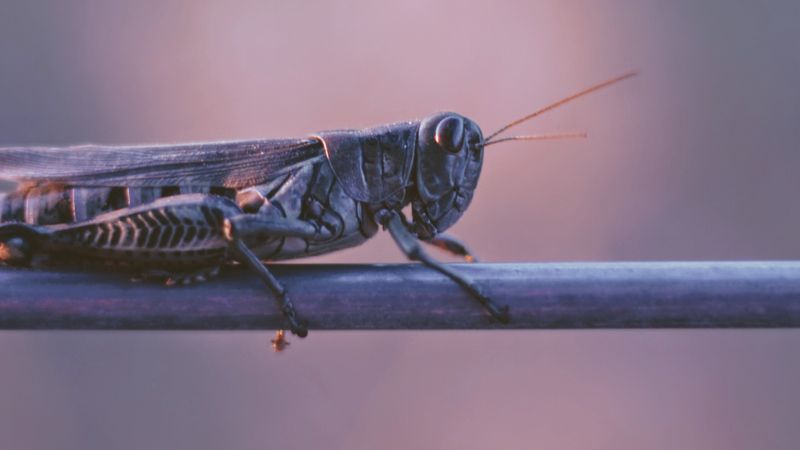Brain-machine interfaces for insects to study principles of odor-guided navigation
Barani Raman, professor of biomedical engineering in the McKelvey School of Engineering, is leading a multidisciplinary team to study how the locust brain transforms sensory input into behavior with a four-year, $4.3 million grant from the National Science Foundation’s Integrative Strategies for Understanding Neural and Cognitive Systems (NCS) program.

Photo by Joshua Hoehne on Unsplash
This article was first published on
engineering.wustl.eduThis article originally appeared in McKelvey School of Engineering and has been republished with permission.
The locust follows a pleasant scent on a treadmill. (Credit: Raman lab)
The inviting smell of a freshly baked cookie immediately triggers a motor response to search for the source of that smell. Often the cookie can be easily found.
This everyday event that we perform without a thought is an amazing feat that combines our superior ability to smell the cookie and computational prowess to determine the directions to move toward the cookie. Robots that possess similar capabilities are yet to be developed as the basic biological principles that are needed to perform this task are yet to be fully understood.
The ability to study neural responses in behaving insects is essential to understanding the robust solutions biological systems have developed for several engineering problems. For example, locusts have survived for at least 8 million years — longer than humans have been on this planet — in nearly all parts of the earth. Their many remarkable capabilities include seeing, hearing and smelling things that humans cannot sense, jumping multiple times their body length, the uncanny ability to fly up to 100 kilometers a day, and switching between solitary and menacing swarms phases as needed for survival. They use these capabilities to find food, avoid predators, propagate their species, and do all things necessary to keep them alive. Researchers in the McKelvey School of Engineering at Washington University in St. Louis have long sought to understand the power of the locusts’ sensing, computing and locomotory capabilities.
Barani Raman, professor of biomedical engineering in the McKelvey School of Engineering, is leading a multidisciplinary team to study how the locust brain transforms sensory input into behavior with a four-year, $4.3 million grant from the National Science Foundation’s Integrative Strategies for Understanding Neural and Cognitive Systems (NCS) program. The grant converges years of research in Raman’s lab with that of his longtime WashU collaborators, including Shantanu Chakrabartty, professor of electrical & systems engineering, and Srikanth Singamaneni, professor of mechanical engineering & materials science, as well as Alexandra Rutz, assistant professor of biomedical engineering, and Yehuda Ben-Shahar, professor of biology, also at WashU.
“Insects are an engineering marvel,” Raman said. “They possess diverse sensing modalities and locomotory responses yet contained in such a small package. We want to engineer tools to study the amazing capabilities of these relatively simpler organisms.”
The research brings together Washington University’s strengths in neural engineering, integrated circuits, biomaterials, synthetic biology and genetic engineering to understand how the insects use olfactory cues to navigate toward an odor source, which could potentially be used for various applications, such as detecting gas left on in the kitchen or as the proverbial canary in the coal mine to test spaces for hazardous chemicals. In 2024, the team plans to launch the first-of-its-kind Center for Cyborg and Biorobotics Research (CyBoR) to formally conduct the research.
The team plans to study the neural response in the locusts’ brains by having the locusts follow a specific odor on a specially built treadmill while walking on a foam ball and while flying in a wind tunnel. By studying their movements and neural activity in the brain in response to these odors, the team can process the information using a custom microchip to develop a “cyborg,” or mobile robot or drone, that can mimic the locusts’ behaviors. They also aim to augment the locusts’ ability to detect certain odors over others.
“Nature already has endowed this organism with various capabilities, so why not understand and augment those capabilities using synthetic mechanisms?” asked Chakrabartty, whose expertise is in sensors and integrated circuits. “Ultimately, our goal is to design a completely synthetic system that has similar remarkable capabilities.”
While the team has already joined forces to create recording instruments and nanomaterials to manipulate neural and behavioral responses, they will continue to improve on those as they develop the bio-hybrid and mobile robotic systems.
“One of the important challenges in these studies is the limited stability of the neural recording and stimulation electrodes and interfaces over a long period,” said Singamaneni, whose expertise is in novel bio- and nanomaterials. “We aim to design and realize novel anti-inflammatory electrodes and biointerfaces that will enable stable long-term neural recording and stimulation.”
Previously, the research team developed a miniature “backpack” containing sensors that recorded the locusts’ brain activity when exposed to the odors. However, the existing backpack is too heavy for the locusts to wear while flying, so the team will work to reduce its weight.
At Washington University, the research is underway in a state-of-the-art CyBoR facility that includes the habitat for the locusts, the treadmill, the wind tunnel, specialized microscopes, and space for visiting researchers as well as for visitors interested in learning about the insects. WashU students also will be included in the research as well as students from the community through various outreach programs.
Other co-investigators include Alper Bozkurt, distinguished professor of electrical & computer engineering at North Carolina State University, who will lead efforts on instrumentation for navigation control; Sawyer Fuller, assistant professor of mechanical engineering at the University of Washington, who will lead efforts to build miniaturized robots that incorporate both biological and engineering elements; and Nabil Imam, assistant professor of computational science and engineering at Georgia Tech, who will lead the development of neuromorphic algorithms and hardware in the bio-hybrid and robotic systems.

